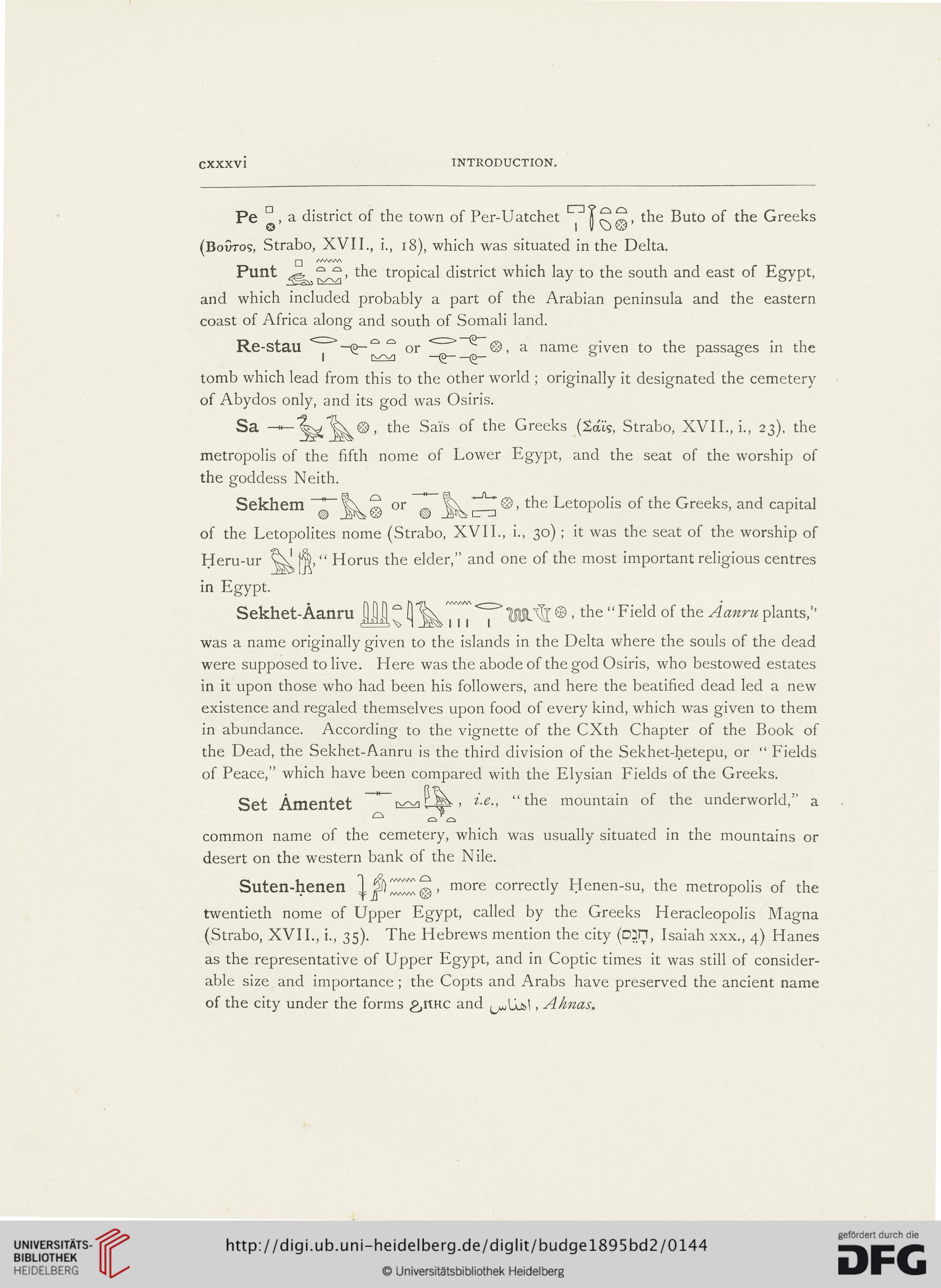CXXXVl
INTRODUCTION.
Pe ° , a district of the town of Per-Uatchet the Buto of the Greeks
(Bouto9, Strabo, XVII., i., 18), which was situated in the Delta.
[—| /VWWA
Punt the tropical district which lay to the south and east of Egypt,
and which included probably a part of the Arabian peninsula and the eastern
coast of Africa along and south of Somali land.
Re-stau Q or a name given to the passages in the
I —(O——& r t>
tomb which lead from this to the other world ; originally it designated the cemetery
of Abydos only, and its god was Osiris.
Sa —1«— the Sai’s of the Greeks (tal's, Strabo, XVII., i., 23), the
metropolis of the fifth nome of Lower Egypt, and the seat of the worship of
the goddess Neith.
Sekhem q jUv© or © the Letopolis of the Greeks, and capital
of the Letopolites nome (Strabo, XVII., i., 30); it was the seat of the worship of
Heru-ur Horus the elder,” and one of the most important religious centres
in Egypt.
• r\ i\ r\ r\ /VW'/V\ _ *
Sekhet-Aanru l] f WL'tfl ® , the “ Field of the Aanru plants,’’
was a name originally given to the islands in the Delta where the souls of the dead
were supposed to live. Here was the abode of the god Osiris, who bestowed estates
in it upon those who had been his followers, and here the beatified dead led a new
existence and regaled themselves upon food of every kind, which was given to them
in abundance. According to the vignette of the CXth Chapter of the Book of
the Dead, the Sekhet-Aanru is the third division of the Sekhet-hetepu, or “ Fields
of Peace,” which have been compared with the Elysian Fields of the Greeks.
Set Amentet t\^i ■ i-e., “the mountain of the underworld,” a
common name of the cemetery, which was usually situated in the mountains or
desert on the western bank of the Nile.
Suten-henen more correctly Henen-su, the metropolis of the
twentieth nome of Upper Egypt, called by the Greeks Heracleopolis Magna
(Strabo, XVII., i., 35). The Hebrews mention the city (D?n, Isaiah xxx., 4) Hanes
as the representative of Upper Egypt, and in Coptic times it was still of consider-
able size and importance ; the Copts and Arabs have preserved the ancient name
of the city under the forms £,riHC and , Ahnas.
INTRODUCTION.
Pe ° , a district of the town of Per-Uatchet the Buto of the Greeks
(Bouto9, Strabo, XVII., i., 18), which was situated in the Delta.
[—| /VWWA
Punt the tropical district which lay to the south and east of Egypt,
and which included probably a part of the Arabian peninsula and the eastern
coast of Africa along and south of Somali land.
Re-stau Q or a name given to the passages in the
I —(O——& r t>
tomb which lead from this to the other world ; originally it designated the cemetery
of Abydos only, and its god was Osiris.
Sa —1«— the Sai’s of the Greeks (tal's, Strabo, XVII., i., 23), the
metropolis of the fifth nome of Lower Egypt, and the seat of the worship of
the goddess Neith.
Sekhem q jUv© or © the Letopolis of the Greeks, and capital
of the Letopolites nome (Strabo, XVII., i., 30); it was the seat of the worship of
Heru-ur Horus the elder,” and one of the most important religious centres
in Egypt.
• r\ i\ r\ r\ /VW'/V\ _ *
Sekhet-Aanru l] f WL'tfl ® , the “ Field of the Aanru plants,’’
was a name originally given to the islands in the Delta where the souls of the dead
were supposed to live. Here was the abode of the god Osiris, who bestowed estates
in it upon those who had been his followers, and here the beatified dead led a new
existence and regaled themselves upon food of every kind, which was given to them
in abundance. According to the vignette of the CXth Chapter of the Book of
the Dead, the Sekhet-Aanru is the third division of the Sekhet-hetepu, or “ Fields
of Peace,” which have been compared with the Elysian Fields of the Greeks.
Set Amentet t\^i ■ i-e., “the mountain of the underworld,” a
common name of the cemetery, which was usually situated in the mountains or
desert on the western bank of the Nile.
Suten-henen more correctly Henen-su, the metropolis of the
twentieth nome of Upper Egypt, called by the Greeks Heracleopolis Magna
(Strabo, XVII., i., 35). The Hebrews mention the city (D?n, Isaiah xxx., 4) Hanes
as the representative of Upper Egypt, and in Coptic times it was still of consider-
able size and importance ; the Copts and Arabs have preserved the ancient name
of the city under the forms £,riHC and , Ahnas.




